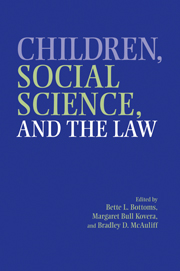Book contents
- Frontmatter
- Contents
- Acknowledgments
- Contributors
- 1 Children, Social Science, and the Law: An Introduction to the Issues
- PART I CHILDREN'S RIGHTS, THEIR CAPABILITIES, AND SOCIETY'S RESPONSIBILITIES TO CHILDREN
- PART II CHILDREN AND FAMILY CHANGE
- PART III JUVENILE AGGRESSION AND JUVENILE JUSTICE
- PART IV CHILDREN AS VICTIMS AND WITNESSES
- 12 The Effects of Community Violence on Children and Adolescents: Intervention and Social Policy
- 13 Preventing Child Abuse and Neglect
- 14 Children's Eyewitness Memory: True Disclosures and False Reports
- 15 Expert Testimony on the Suggestibility of Children: Does It Fit?
- 16 The Status of Evidentiary and Procedural Innovations in Child Abuse Proceedings
- PART V CONCLUSIONS AND FUTURE DIRECTIONS
- Author Index
- Case Index
- Subject Index
- References
14 - Children's Eyewitness Memory: True Disclosures and False Reports
Published online by Cambridge University Press: 24 July 2009
- Frontmatter
- Contents
- Acknowledgments
- Contributors
- 1 Children, Social Science, and the Law: An Introduction to the Issues
- PART I CHILDREN'S RIGHTS, THEIR CAPABILITIES, AND SOCIETY'S RESPONSIBILITIES TO CHILDREN
- PART II CHILDREN AND FAMILY CHANGE
- PART III JUVENILE AGGRESSION AND JUVENILE JUSTICE
- PART IV CHILDREN AS VICTIMS AND WITNESSES
- 12 The Effects of Community Violence on Children and Adolescents: Intervention and Social Policy
- 13 Preventing Child Abuse and Neglect
- 14 Children's Eyewitness Memory: True Disclosures and False Reports
- 15 Expert Testimony on the Suggestibility of Children: Does It Fit?
- 16 The Status of Evidentiary and Procedural Innovations in Child Abuse Proceedings
- PART V CONCLUSIONS AND FUTURE DIRECTIONS
- Author Index
- Case Index
- Subject Index
- References
Summary
Hand in hand with society's increased awareness of the problem of child abuse has come an increased presence of children as eyewitnesses in the legal system. Whether testifying as victims in open court or providing bystander eyewitness reports in a forensic interview, children have a good deal of valuable information to give the justice system, and in cases that rely largely on eyewitness evidence, a just outcome may rest on the testimony of a child. Despite children's strengths and abilities as eyewitnesses, children's memory, like that of adults, is not infallible, and children in some situations may be more susceptible to minor and serious error than adults. In this chapter, we overview how children perform when called on to provide eyewitness information about experienced events and also how they perform when questioned about never-experienced events. The chapter is divided into four main sections: disclosure of abuse, trauma and memory, false memory, and current trends in legal and research arenas. Overall,weargue that (a) children are often, although not always hesitant to disclose abuse; (b) children have the capacity for accurate memories of abusive experiences; (c) many children can, to a certain degree, resist suggestive questions about abuse, although some children (especially preschoolers) are more prone to false report, especially in multiply suggestive contexts; and (d) the current focus on false reports and false memory, although clearly important, often overstates the problem of children's suggestibility about abuse and risks disbelief of child witnesses when belief is justified (for discussion, see also Lyon, this volume).
- Type
- Chapter
- Information
- Children, Social Science, and the Law , pp. 342 - 377Publisher: Cambridge University PressPrint publication year: 2002
References
- 5
- Cited by

